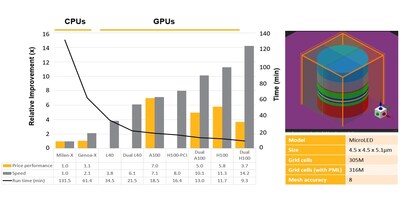Ansys, TSMC, and Microsoft collaborate to speed-up
simulation and analysis of silicon photonic components over
10X
/ Key Highlights
- Ansys Lumerical™ FDTD 3D electromagnetic simulation
software for photonic components demonstrates 10X faster simulation
with Microsoft Azure Virtual Machines using NVIDIA graphics
processing units (GPUs)
- With the scalability of Azure cloud, Ansys software
delivers a comprehensive platform ideal for ushering in the next
wave of silicon Photonic Integrated Circuit (PIC) technology for
applications in data communications, biomedical tools, automotive
LiDAR systems, and artificial intelligence (AI)
PITTSBURGH, Sept. 24,
2024 /PRNewswire/ -- Ansys (NASDAQ: ANSS) and
TSMC today announced a successful pilot with Microsoft that
significantly speeds-up the simulation and analysis of silicon
photonic components. Together, the companies achieved over 10X
speed-up of Ansys Lumerical FDTD photonics simulation via Microsoft
Azure NC A100v4-series virtual machines, powered by NVIDIA
accelerated computing running on Azure AI infrastructure.
PICs are integral to applications across industries, including
data communications, biomedical tools, automotive LiDAR systems,
artificial intelligence, and more.

Silicon PIC, a type of optical communications that enables data
to travel farther and faster, is integral to hyperscale data
centers and Internet-of-Things applications. Combining photonic and
electronic circuits is a painstaking task requiring precise
multiphysics design and fabrication. A minor misstep can create
continuity challenges within chips, which can result in added cost
and timeline setbacks up to several months.
To alleviate challenges and unlock the ultra-bandwidth
capabilities of silicon PIC, TSMC collaborated with Ansys to
speed-up Lumerical FDTD simulations using highly efficient Azure
virtual machines that use NVIDIA GPUs. Azure NC A100v4 VMs executed
the simulations and identified optimal resources that balance cost
with performance. The overall result is seamless deployment,
graphical interface access, scaling of distributed simulations, and
post processing for large datasets in cloud environments. For a
consistent end-to-end digital engineering workflow, Azure Virtual
Desktop provided a seamless transition to the cloud by delivering
the same user experience as on a desktop.
"The size and complexity of our multiphysics silicon solutions
makes the process of simulating all possible parameter combinations
challenging," said Stefan Rusu, head
of silicon photonics system design at TSMC. "This latest
collaboration again highlights that Ansys effectively harnesses the
latest cloud infrastructure and techniques to deliver powerful,
predictively accurate solutions that produce results in a fraction
of the time."
Deploying Lumerical FDTD on the cloud enables designers to
swiftly identify optimal chip designs that account for the
multiphysics challenges related to combining photonic circuits with
electronic circuits.
"Ansys has developed unique capabilities that can be closely
coupled with our leading multiphysics simulation engines for
photonics," said John Lee, vice
president and general manager of the semiconductor, electronics,
and optics business unit at Ansys. "Collaborating with TSMC and
Microsoft has accelerated technologies that address high-speed
optical data transfer, which is one of the most important chip
design challenges today."
Shelly Blackburn, CVP of Azure
Infrastructure, Digital and App Innovation at Microsoft,
highlighted the benefits of the ongoing collaboration with Ansys
and TSMC. "Our collaboration is a significant advantage for users
seeking the combined power of HPC and AI, using the flexibility of
cloud solutions while maintaining the familiar on-premises
experience," she said. "By working together, we aim to address the
complexities of large-scale designs essential for high-quality
semiconductor products. Utilizing the power and scalability of
Microsoft Azure's cloud computing is a key strategy in overcoming
these challenges."
/ About Ansys
Our Mission: Powering Innovation that Drives Human
Advancement™.
When visionary companies need to know how their world-changing
ideas will perform, they close the gap between design and reality
with Ansys simulation. For more than 50 years, Ansys software has
enabled innovators across industries to push boundaries by using
the predictive power of simulation. From sustainable transportation
to advanced semiconductors, from satellite systems to life-saving
medical devices, the next great leaps in human advancement will be
powered by Ansys.
Ansys and any and all ANSYS, Inc. brand, product, service and
feature names, logos and slogans are registered trademarks or
trademarks of ANSYS, Inc. or its subsidiaries in the United States or other countries. All
other brand, product, service and feature names or trademarks are
the property of their respective owners.
ANSS–T
/ Contacts
|
Media
|
Mary Kate
Joyce
|
|
724.820.4368
|
|
marykate.joyce@ansys.com
|
|
|
|
Investors
|
Kelsey
DeBriyn
|
|
724.820.3927
|
|
kelsey.debriyn@ansys.com
|
 View original content to download
multimedia:https://www.prnewswire.com/news-releases/tsmc-collaborates-with-ansys-and-microsoft-to-accelerate-photonic-simulations-302255918.html
View original content to download
multimedia:https://www.prnewswire.com/news-releases/tsmc-collaborates-with-ansys-and-microsoft-to-accelerate-photonic-simulations-302255918.html
SOURCE Ansys